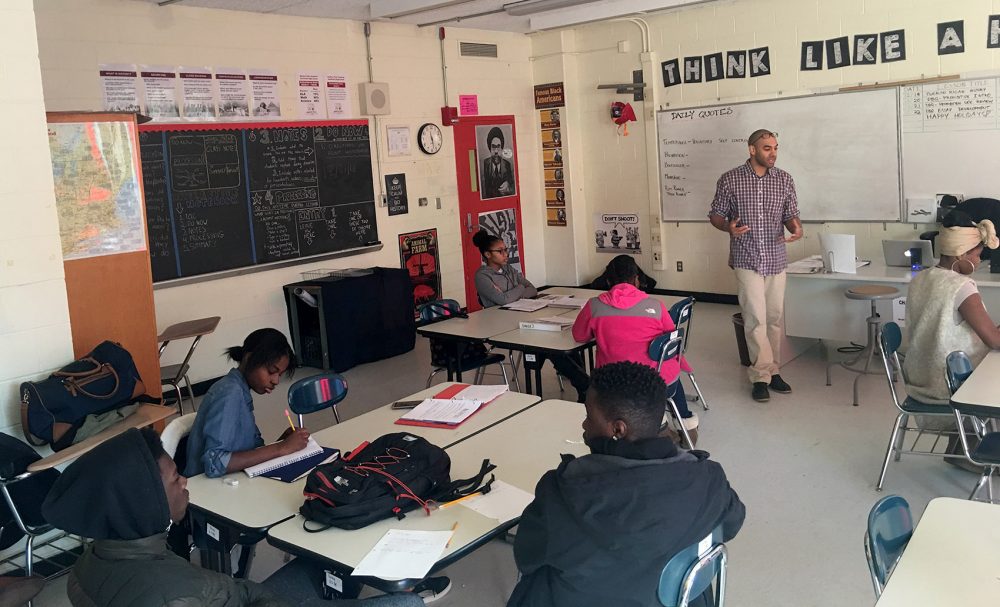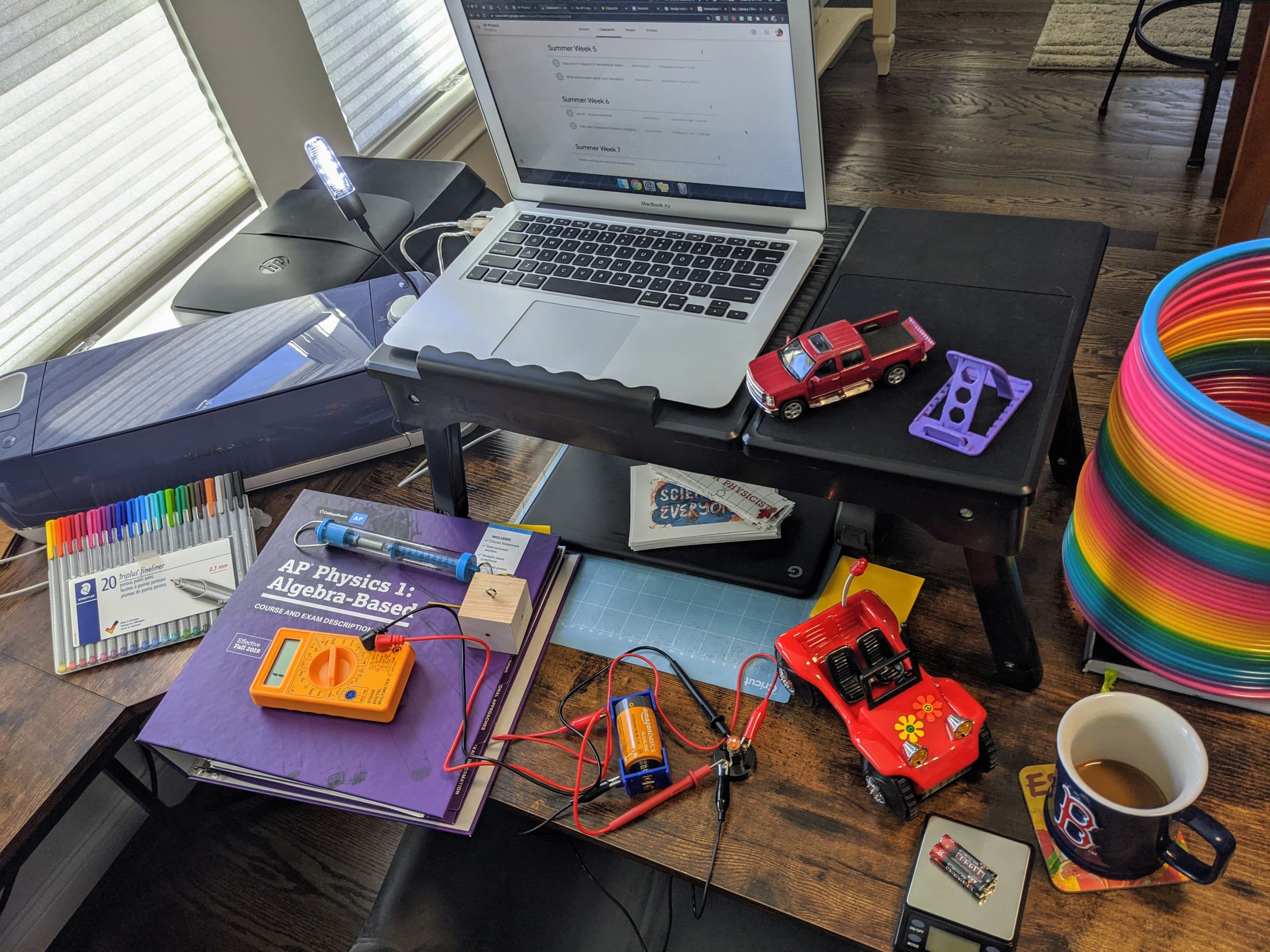Advertisement
Is Virtual Learning Best From An Actual Classroom? Experts Question State Recommendation

Across Massachusetts, many educators are bridling at the “recommendation” of state officials that they enter classrooms this fall, even if they are teaching entirely remotely.
Some online-learning experts have raised a series of concerns about the guidance, arguing that it asks teachers to incur health risks for uncertain educational gains.
To some teachers, it seems to presume that, absent commutes and watchful principals, educators will fail to meet the needs of nearly a million schoolchildren at risk of academic backsliding.
“We’re not being given the same opportunity to prove ourselves working from home that pretty much every other industry is being given right now,” said Savannah Lodge-Scharff, who teaches physics at Madison Park Technical Vocational High School.
For her part, Lodge-Scharff has already prepared to deliver her first month of physics lessons from her home in Roxbury — with a supply of alligator clips and other circuitry equipment, remote-control cars, and calculators to be used by her Advanced Placement students.
“This is something that we’ve been working on for months,” she said. “Adaptability is something that comes with teaching.”
Her experience reflects the findings of MIT’s Teaching Systems Lab across hundreds of interviews with teachers this year.
“Almost every teacher I’ve spoken with has talked about how much more work they’re doing during this period — they’re re-devising their whole curriculum,” said Justin Reich, the lab’s director.
Reich granted that of course there are different levels of ingenuity and commitment among teachers: “Every profession has people that are lazy and venal and not well-suited for their work.” But he added that in all his lab’s post-pandemic interviews, “the topic of ‘lazy colleagues’ has simply never come up.”
Some professionals in online learning agreed that remote learning need not mean disengaged teachers.
K12, a private company behind dozens of online schools across the United States, relies on a workforce of licensed teachers who work entirely from their homes.
Advertisement
“There’s this misconception that somehow, if folks are remote, productivity suffers. That’s just not the case,” said Jeanna Pignatiello, K12’s chief academic officer. “School officials just need to be equipped to manage a remote workforce.”

Why In-Person?
In a statement, Colleen Quinn — a spokesperson for the state’s executive office of education — reiterated the guidance that “in remote scenarios, instruction from the classroom is the most effective educational environment.”
“Schools can ensure that students receive a structured, engaging and consistent learning experience while offering teachers access to reliable resources and stability,” Quinn added.
Riley — the state’s commissioner of elementary and secondary education — offered several specific rationales alongside last week's guidance.
The list included one notable administrative advantage: that when teachers are physically present in a shared space, it “allow[s] administrators to monitor the level and amount of instruction students receive” each day.
At K12, entirely remote teachers still face the prospect of drop-in visits by overseers, either during live learning sessions, or in reviews of recordings later. “It’s very well-understood that school administrators, principals, will be in and out of classrooms — just like they were in brick-and-mortar,” Pignatiello said.
Most of Riley's arguments concerned teaching and learning. Students communicating with a teacher in a classroom, albeit via videoconference, would experience “familiarity” and “consistency,” while teachers would have access to a “broad range of instructional materials,” “reliable internet access” — and a chance to collaborate.
Lodge-Scharff, for one, isn’t swayed. At Madison Park, she said, teachers “can’t gather in the school. We don’t have great ventilation, or hot water. A lot of the windows don’t open. And having to wear a mask during a Zoom call would be an interesting experience.”
A recent outbreak among summer staff at a school in Athol underlined the need for adults to wear masks even in sparsely-populated buildings.
But that would make teaching over video a great deal more difficult, Reich said: “Human teaching requires human communication. And our faces are really important.”
Reich said he isn’t aware of any hard scholarly evidence to support the idea that online teaching is more successful when done from a school building. But then, he added, that’s not surprising — because it hasn’t been necessary before.
He sympathized with state policymakers, but said there are just as many good arguments for letting teachers work from home as for the proposed alternative. “You might have less chance of encountering an infected adult. You might actually have better internet access [at home]. And you might be able to avoid 45 minutes commuting both ways.”
In the end, he said it isn’t clear that DESE’s guidance is “in the best interest of students and teachers" — giving the example of schools with shaky Internet connections as one cause for doubt. (Lodge-Scharff said her home connection is "definitely" better than the one at school, for one.)
She noted that COVID-19 has already disrupted the learning of her students at Madison Park, where the state classifies nearly 92% of those enrolled as “high needs.” In the spring, “a lot of our students had to work because their parents got laid off. The work/life balance was really difficult,” she said.
Then again, “as a scientist,” she said she had to weigh that toll against the health risks — still palpable on her campus: “We had several students who were sick during the spring. There were parents who were hospitalized. There were teachers who were sick and needed to take time off. It hit our community really hard.”
“I understand [our] students have the highest needs. But they’re also the most at risk,” Lodge-Scharff said, pointing at far higher rates of infection among the city’s Black and Latino communities.
If asked to report to the building with the virus still spreading, Lodge-Scharff — who has asthma — said she would either seek an accommodation from the district’s office of equity or consider taking a leave of absence.
"We’re not being given the same opportunity to prove ourselves working from home that pretty much every other industry is being given right now."
Physics teacher Savannah Lodge-Scharff
The Boston Teachers Union has already suggested that they will ignore the state directive insofar as it conflicts with public health. “Risking unneeded exposure for thousands of educators across the state is contradictory to the Governor’s request that those who can work from home should,” said Jessica Tang, the union’s president.
After lots of preparatory work this summer, Lodge-Scharff is hopeful. “All of the evidence that I have suggests that remote learning is actually going to be better, pedagogically” than the prospect of distanced, in-person teaching, she said.
Justin Reich, too, said he hopes that parents and policymakers have a balanced vision of the two fall options before them. He noted one “unfortunate dynamic” — that “people are comparing the worst, most chaotic remote learning from the spring with their vision of in-person learning, which is still stuck in January 2020.”
In fact, when schools do reopen in person, “they’re going to be really different,” Reich said. Good teachers — who would normally engage closely with students — won’t have that option during an in-person, socially-distanced fall.
Reich closed with what has become a sad refrain among both teachers and policymakers during the pandemic period: “All of our choices are really bad — and that’s because, as a country, we’ve failed to manage the outbreak of this disease."
